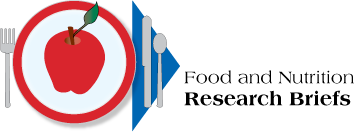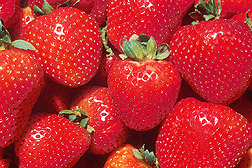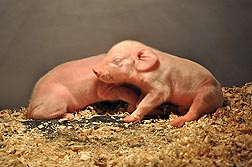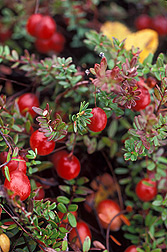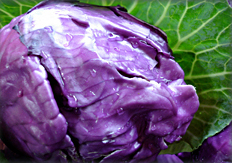| April 2008 |
Calcium Requirements May Be OverestimatedAgricultural Research Service (ARS) scientists have reported study findings that suggest calcium's current recommended amount, called "adequate intake" or AI, for American adults aged 19 or older may be greater than necessary. The data collected in this study suggest that the average amount of dietary calcium needed to maintain a neutral calcium balance is about 741 mg per day. Scientific contact: Curtiss Hunt, (701) 795-8423, ARS Grand Forks Human Nutrition Research Center, Grand Forks, N.D. |
|
|
|
Portion Size, Energy Density are Key Components in Kids' Caloric IntakeA study at the Agricultural Research Service (ARS) Children’s Nutrition Research Center in Houston, Texas, has shown that serving large portions of energy-dense foods at meals can result in substantial extra calories consumed by U.S. preschoolers. Results showed that children ate one-third more entree calories when either an energy-dense or large-portion meal was served. However, combining the larger portions with the higher energy density added the most calories to the meal. When children were served a large portion of the energy-dense entree, they ate 75 percent more entree calories and 35 percent more total calories at the meal. Scientific contact: Jennifer Fisher, (713) 798-6766, ARS Children’s Nutrition Research Center, Houston, Texas. |
Vitamin A Suppresses Type 1 Diabetes in Animal StudyA study by Agricultural Research Service (ARS) nutrition scientists has shown, for the first time, that high levels of vitamin A can suppress development of type 1 diabetes in laboratory mice prone to that disease. Blood sugar levels of 45 mice in the experiment were taken regularly to determine onset of diabetes. At about seven months, only 25 percent of those mice eating a high-vitamin-A feed, and 33 percent of those eating grape-powder-enriched feed, had developed type 1 diabetes, while 71 percent of those on non-enriched feed had became diabetic. Scientific contact: Charles B. Stephensen, (530) 754-9266, ARS Western Human Nutrition Research Center, Davis , Calif. |
|
|
|
Food Compounds That Kill Test-Tube Cancer Cells AnalyzedStrawberries, grapes, blueberries and some familiar seasonings like rosemary contain compounds that can—in test tubes—kill cells of a childhood cancer. Nutrition-focused research by molecular biologist Susan J. Zunino of the Agricultural Research Service (ARS) Western Human Nutrition Research Center in Davis, Calif., may reveal exactly how the powerful plant chemicals fight the disease known as acute lymphoblastic leukemia. Her investigations provide some new clues about how phytochemicals attack cancer cells. For example, she found that the phytochemicals interfere with the orderly operations of mitochondria, the miniature energy-producing power plants inside cells. Without energy, cells die. Mitochondria exposed to resveratrol and the other phytochemicals that Zunino tested couldn't function properly. But more work is needed to fully understand how the phytochemicals achieved that. Scientific contact: Susan J. Zunino, (530) 752-5156, ARS Western Human Nutrition Research Center, Davis, Calif. |
Getting Grade School Kids to Eat More Fruits and VeggiesOne approach frequently suggested as an effective way to increase children's consumption of healthy foods is to encourage them to participate in food preparation activities. Now a study conducted by scientists with the Agricultural Research Service (ARS) Children's Nutrition Research Center in Houston, Texas, has demonstrated that this may be an effective approach. The researchers observed an average increase in consumption of one serving per day of fruit, 100-percent fruit juice, or vegetables, compared to the beginning of the study. Girls and Hispanic students achieved the most recipe-preparation goals. Scientific contact: Karen Cullen, (713) 798-6764, ARS Children's Nutrition Research Center, Houston, Texas. |
|
|
|
State, National Nutrition Information on Updated WebsiteAn updated web resource that provides a snapshot of state and national health and nutrition indicators has been launched by Agricultural Research Service (ARS) scientists. The resource, called the Community Nutrition Map (CNMap)Version 2, was developed at the ARS Beltsville Human Nutrition Research Center at Beltsville, Md. Easy-to-read customized tables and color-coded maps can be accessed by anyone on the Internet. Indicators include data on estimated nutrient intakes, eating patterns, physical activity, body weight, demographics and food security. Policy makers and public health workers can use these profiles to investigate diet and health issues that may be of concern both at the local and state level. Scientific contact: Ellen W. Harris, (301) 504-7365, ARS Beltsville Human Nutrition Research Center, Beltsville, Md. |
Common Plant Compound Improves Iron AbsorptionSwine research funded in part by the Agricultural Research Service (ARS) indicates that inulin, a complex carbohydrate found in many plants worldwide, may help people absorb more iron from fruits, vegetables and grains. This finding by ARS plant physiologist Ross Welch and his colleagues could provide key support in the worldwide fight against iron deficiency. Pigs that ate grains supplemented with 4 percent inulin showed a 28 percent improvement in absorbable iron and a 15 percent improvement in blood hemoglobin concentration over those consuming inulin-free feed. They also had higher soluble iron concentrations in the proximal, mid and distal colon. Scientific contact: Ross Welch, (607) 255-5434, U.S. Plant, Soil and Nutrition Research Laboratory, Ithaca, N.Y. |
|
|
|
Researchers Look at How Frequency of Meals May Affect HealthThe health consequences of eating one large meal a day compared with eating three meals a day has not been established. Now two recently published journal articles are among the first to report the effects of meal skipping on key health outcomes, based on a study involving a group of normal-weight, middle-aged adults. The first study analysis showed that consuming a one-meal-per-day diet, rather than a traditional three-meal-per-day diet, is feasible for a short duration. It showed that when the volunteers were "one-mealers," they had significant increases in total cholesterol, LDL "bad" cholesterol and in blood pressure, compared to when they were "three-mealers." The changes in cardiovascular disease risk factors occurred despite the fact that the "one-mealers" saw slight decreases in their weight and fat mass in comparison to when they were "three-mealers." Further analysis of the study group showed that when the volunteers were "one-mealers," they had higher morning fasting blood sugar levels, higher and more sustained elevations in blood sugar concentrations, and a delayed response to the body's insulin, compared to when they were "three-mealers." Scientific contact: David J. Baer, (301) 504-8719, ARS Beltsville Human Nutrition Research Center, Beltsville, Md |
New Cranberry Packed with Health FeaturesAgricultural Research Service (ARS) scientists and colleagues are using traditional breeding methods to suit up a wholesome new cranberry line with a readily absorbable dose of healthful antioxidants. The team found an attractive cranberry species from Alaska that is genetically similar enough to the American cranberry to produce fertile progeny. The Alaskan species is also attractive because some of the fruit's many healthful chemical compounds, called anthocyanins, are glucose-linked. In nature, most anthocyanins are bound to sugars. Those that are bound to glucose sugar are relatively high in antioxidant capacity and are well absorbed in the human gut. In contrast, the anthocyanins found in the American cranberry are mainly bound to other kinds of sugars, so they are less easily absorbed. The researchers found that, compared to the typical American cranberry's anthocyanins, which are 3 to 5 percent glucose-linked, the anthocyanins in hybrids from the first breeding cross were 50 percent glucose-linked. Scientific contact: James J. Polashock, (609) 726-1590, ARS Genetic Improvement of Fruits and Vegetables Laboratory, Chatsworth, N.J. |
|
|
|
When It Comes to Red Cabbage, More Is BetterAgricultural Research Service (ARS) scientists have identified 36 anthocyanins in red cabbage, including eight that had never before been detected in the cabbage. Now the ARS scientists are learning more about these compounds and their absorption into the human blood stream. Twelve volunteers consumed three different amounts of cooked red cabbage along with a full diet of carefully controlled foods. Each volunteer completed three two-day meal regimens, which included 2/3 cup, 1-1/3 cups, or 2 cups of red cabbage. The volunteers were capable of absorbing the most anthocyanins when given the largest serving of cooked cabbage. Interestingly, the anthocyanins that the researchers identified were not equally absorbed, as measured by the portion of the ingested compound that reached the blood stream. Nearly 80 percent of cabbage anthocyanins tested were "acylated," meaning attached to acyl groups, which made them more stable and less absorbable. The non-acylated anthocyanins present were at least four times more bioavailable, or absorbed, than the acylated anthocyanins. Scientific contact: Janet Novotny, (301) 504-8263, ARS Beltsville Human Nutrition Research Center, Beltsville, Md. |

